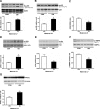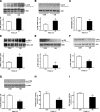Overnutrition and maternal obesity in sheep pregnancy alter the JNK-IRS-1 signaling cascades and cardiac function in the fetal heart
- PMID: 20110268
- PMCID: PMC2874473
- DOI: 10.1096/fj.09-142315
Overnutrition and maternal obesity in sheep pregnancy alter the JNK-IRS-1 signaling cascades and cardiac function in the fetal heart
Abstract
Maternal obesity in pregnancy predisposes offspring to insulin resistance and associated cardiovascular disease. Here, we used a well-established sheep model to investigate the effects of maternal obesity on cardiac functions. Multiparous ewes were assigned to a control (CON) diet [100% of National Research Council (NRC) recommendations] or an obesogenic (OB) diet (150% of NRC recommendations) from 60 d before conception to necropsy on d 135 of pregnancy. Fetal blood glucose and insulin were increased (P<0.01, n=8) in OB (35.09+/-2.03 mg/dl and 3.40+/-1.43 microU/ml, respectively) vs. CON ewes (23.80+/-1.38 mg/dl and 0.769+/-0.256 microU/ml). Phosphorylation of AMP-activated protein kinase (AMPK), a cardioprotective signaling pathway, was reduced (P<0.05), while the stress signaling pathway, p38 MAPK, was up-regulated (P<0.05) in OB maternal and fetal hearts. Phosphorylation of c-Jun N-terminal kinase (JNK) and insulin receptor substrate-1 (IRS-1) at Ser-307 were increased (P<0.05) in OB fetal heart associated with lower downstream PI3K-Akt activity (P<0.05), indicating impaired cardiac insulin signaling. Although OB fetal hearts exhibited a normal contractile function vs. CON fetal hearts during basal perfusion, they developed an impaired heart-rate-left-ventricular-developed pressure product in response to high workload stress. Taken together, fetuses of OB mothers demonstrate alterations in cardiac PI3K-Akt, AMPK, and JNK-IRS-1 signaling pathways that would predispose them to insulin resistance and cardiac dysfunction.
Figures






References
-
- Ehrenberg H M, Dierker L, Milluzzi C, Mercer B M. Prevalence of maternal obesity in an urban center. Am J Obstet Gynecol. 2002;187:1189–1193. - PubMed
-
- Reece E A. Perspectives on obesity, pregnancy and birth outcomes in the United States: the scope of the problem. Am J Obstet Gynecol. 2008;198:23–27. - PubMed
-
- Nohr E A, Vaeth M, Bech B H, Henriksen T B, Cnattingius S, Olsen J. Maternal obesity and neonatal mortality according to subtypes of preterm birth. Obstet Gynecol. 2007;110:1083–1090. - PubMed
-
- Hull H R, Dinger M K, Knehans A W, Thompson D M, Fields D A. Impact of maternal body mass index on neonate birthweight and body composition. Am J Obstet Gynecol. 2008;198:416 e411–416. - PubMed
-
- Barker D J. Fetal programming of coronary heart disease. Trends Endocrinol Metab. 2002;13:364–368. - PubMed
Publication types
MeSH terms
Substances
Grants and funding
LinkOut - more resources
Full Text Sources
Other Literature Sources
Medical
Research Materials
Miscellaneous

